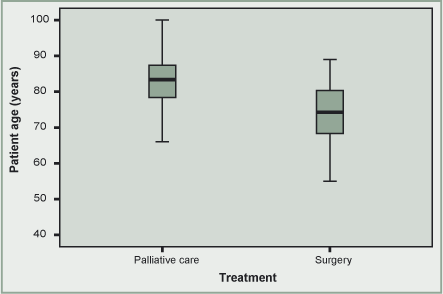Demographics
78 emergency patients received palliative care and did not undergo surgery. The one remaining patient who received palliative care was an elective admission. The average age was 83 years. This compares with an average age of 73 for all emergency patients in whom a decision was made to operate (Figure 1).
Figure 1. Age by type of treatment
64% (50/78) were males compared with 81% (218/268) of males in operated emergency patients.
43% (33/76) of patients were known to have an aortic aneurysm before presentation as an emergency admission, compared with 26% (54/211) of emergency patients who had an operation.
55% (68/124) of emergency admission patients aged 80 or over underwent surgery compared to 90% (196/218) of patients aged less than 80 years. However of the 68 patients aged 80 or over who did have surgery, 37% (25/68) were discharged from hospital within 30 days of surgery and 9% (6/68) were alive but had not left hospital.
Decisions about major emergency surgery on elderly patients are very difficult. NCEPOD has recommended against futile surgery in the past 1. Although, elderly patients undergoing emergency aortic aneurysm repair did survive to 30 days, NCEPOD has no information on the length or quality of life of those who survived. Considerable resources such as the use of scarce critical care beds will have been consumed in caring for all those elderly patients undergoing surgery who did not survive.
Back to top
|

